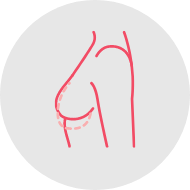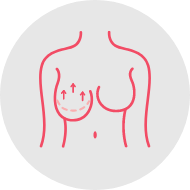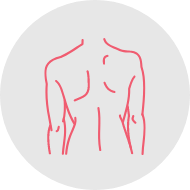Reduction Mammoplasty
Procedures
Breast Reduction (Reduction Mammoplasty)
Reduction mammoplasty, also known as breast reduction surgery, is a procedure that reduces the size and weight of the breasts. For some patients, a larger breast size can be linked to physical symptoms that affect daily activities and comfort.
Common concerns that may be associated with larger breasts include:
- Shoulder and neck tension or discomfort
- Breast discomfort, particularly around menstruation
- Skin irritation or rash beneath the breasts, especially in warmer months
- Difficulty exercising due to breast size
- Headaches or migraines related to posture strain
- Noticeable differences in breast size (asymmetry)
- Changes in breast position over time
This procedure may be considered for patients seeking relief from these physical concerns.
Treatment Outcomes

May reduce breast size

May adjust breast symmetry

May assist with bra-related discomfort

May reduce neck discomfort

May reduce back discomfort

May support physical movement and activity
Allure
Breast Reduction Before and After Gallery – Patient Results
Disclaimer: The outcomes shown are only relevant for these patients and do not necessarily reflect the results other patients may experience, as results may vary due to many factors including the individual’s genetics, diet and exercise.



FREQUENTLY ASKED QUESTIONS
Who may consider reduction mammoplasty?
This procedure may be considered by patients experiencing physical symptoms related to a larger breast size. Patients should be in good general health, not pregnant or breastfeeding, and have a stable weight. Quitting smoking is advised before and after surgery to support healing.
Are there alternatives to surgery?
For some patients, weight management may lead to changes in breast size. However, changes in skin elasticity after weight loss can sometimes result in tissue laxity. In these cases, other procedures such as a breast lift may be discussed.
What are the potential risks?
As with all surgery, risks include bleeding, infection, scarring, and changes in breast or nipple sensation. Other risks may include:
- Delayed wound healing
- Nipple loss
- Fluid accumulation (seroma)
- Fat necrosis
- Asymmetry
- Reduced ability to breastfeed
- Poor scarring or changes in scar appearance
- Need for further procedures
These risks are discussed in detail during the consultation.
What can I expect during recovery?
Recovery after reduction mammoplasty can vary depending on the extent of the procedure, healing response, and overall health. Patients are typically advised to rest for 1 to 2 weeks and avoid strenuous activities. Swelling and bruising are common and usually improve within a few weeks. Heavier physical activities and lifting should be avoided during early recovery. A gradual return to daily tasks may be possible within six weeks.
When will results be noticeable?
Changes in breast size can be seen after surgery, although swelling and healing may affect how the area looks at first. The final result may take several months as the body continues to recover.
What happens after reduction mammoplasty?
Reduction mammoplasty may help reduce physical symptoms such as neck or shoulder discomfort, skin irritation beneath the breasts, and limitations with certain physical tasks. It may also address breast symmetry and support postural comfort. Recovery varies between patients, and final results become clearer as healing progresses.
What factors affect the cost of reduction mammoplasty?
The total cost depends on factors such as the surgical approach, anaesthesia, hospital fees, and whether any other procedures are combined. Medicare rebates or private health insurance may apply if the procedure meets eligibility criteria for medical necessity.

